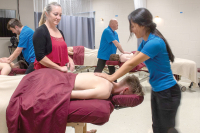Ridding schools of bullying will require changing culture
By Raymond Turpin • Guest Columnist
Bullying, unfortunately, has always existed in the American school systems and it continues to be a pervasive problem. Many historically have dismissed it as a schoolyard rite of passage or just a part of growing up. However, now that these behaviors have been more closely studied, we have learned that bullying is unnecessary, damaging and can cause negative long-term consequences not only for the victim but for the bully as well.
Bullying is deliberate acts of physical or psychological harassment or intimidation. These acts occur repeatedly over time and are carried out by an individual or a group upon another, usually weaker, individual. Direct bullying (favored by boys) includes taunting, threatening, hitting, stealing and property damage. Indirect bullying (favored by girls) includes spreading rumors and enforcing social isolation.
However, direct verbal bullying is still the most common form of bullying for both boys and girls. With this electronically plugged-in generation, bullying has spread into cyberspace where threatening e-mails, slanderous postings and sexual harassment are frequently used to intimidate and control others. Most victims of bullying suffer in relative isolation and research has shown that the majority of these children feel helpless and believe that reporting to adults is ineffective in stopping the bullying and can sometimes lead to worse bullying.
The media have recently reported stories about adolescents who committed suicide because of the effects of being bullied. These victims were often intimidated, excluded and harassed for differences in weight, size, religious beliefs, and sexual orientation. In fact, studies show that gay and lesbian teens are three times more likely to report being bullied than their heterosexual peers and are two to three times more likely to die by suicide.
For many victims of bullying, there are serious potential consequences such as depression, low self-esteem, school avoidance, suicidal thoughts, substance abuse and poor academic and job performance. Bullies who may operate unchecked for years are at risk for not learning appropriate skills for dealing with their problems effectively and with proper respect for others. In one study, 60 percent of those characterized as bullies in grades 6-9 had at least one criminal conviction by age 24.
Related Items
So how should we deal with bullying in the schools? How can we ensure that all children can attend school each day and work to their potential in a supportive environment that is free of intimidation and fear? The majority of school-based bullying interventions have simply focused on the bully and the victim and they have been woefully inadequate for addressing the problem. Bullying is a problem that occurs within a social context, so if intervening with the bully and the victim has been ineffective, it might make sense to try and address the social context in which the bullying is taking place.
Changing the culture of a school will take time and patience, but it should begin with a school having a clearly understandable school-wide policy against bullying that is clearly explained to the students. In addition, it will be important for the school to consistently follow this policy. Educating students and parents about bullying and its destructive effects through parent meetings, classroom discussions and group projects will be necessary.
However, the most important piece of this culture change will be to empower bystanders. Bystanders are usually present at most bullying incidents. A recent study found that peers were present in 85 percent of bullying incidents, but only 10 percent actually intervened even though two-thirds of children report that they know they should intervene. Empower bystanders to speak up against bullying because being questioned and confronted by peers will take away a bully’s sense of power and control. Empower victims to speak up for themselves firmly and assertively. Teach students that the bully is someone who has a problem managing their behavior and the victim is someone they can protect. If one bystander could be courageous enough to take a stand against bullying, others would follow.
Of course schools can only do so much to teach a child about respecting others, tolerating individual differences and standing up for those who are weaker or are being victimized. It really begins at home. Talk to your child but more importantly listen to them.
(Dr. Raymond Turpin is a licensed psychologist and the clinical director and co-owner of Haywood County Psychological Services which provides mental health services to the students and families of the Haywood County Schools. He has been treating child and adolescent mental health issues for 21 years with his specialty being adolescents, trauma, and developmental issues. He has been married for 21 years and has two children, four cats, one dog and fish. He continues to believe in the inherent goodness of people.)









